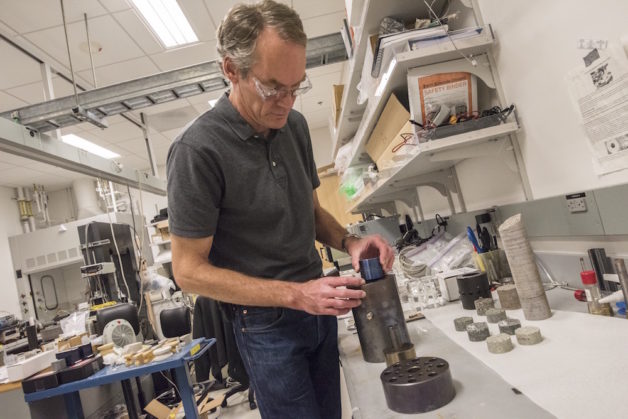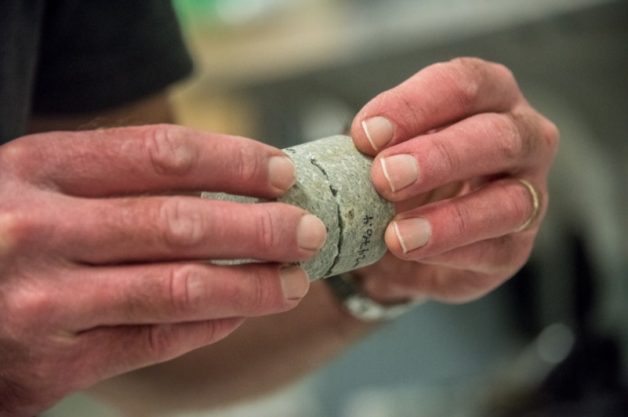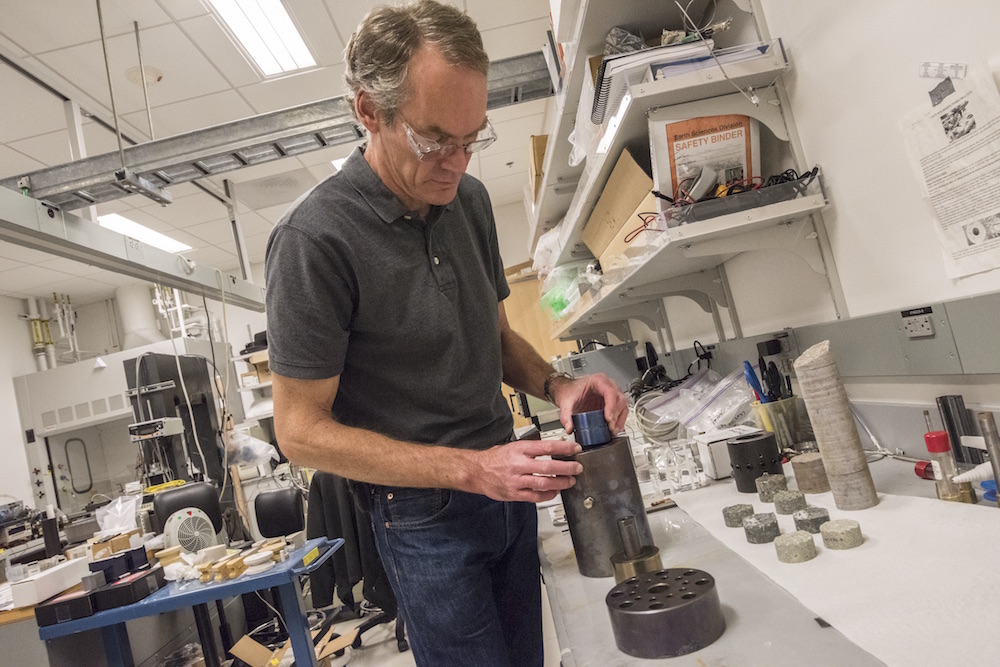
Berkeley Lab scientist Tim Kneafsey demonstrates how he places rock samples, from the Brady Geothermal Field in Nevada, into a stress permeability apparatus, which tests how long a fracture can remain open. (Credit: Marilyn Chung/Berkeley Lab)
The Department of Energy’s Lawrence Berkeley National Laboratory (Berkeley Lab) will lead a new $9 million project aimed at removing technical barriers to commercialization of enhanced geothermal systems (EGS), a clean energy technology with the potential to power 100 million American homes.
Berkeley Lab will partner with seven other DOE national labs and six universities to develop field experiments focused on understanding and modeling rock fractures, an essential element of geothermal systems. Scientists will use the Sanford Underground Research Facility (SURF) in South Dakota to create small-scale fracture networks in crystalline rock 1,500 meters below ground.
“We will be putting instrumentation within tens of meters of the fractures and will be able to detect fracturing at a higher resolution than what has ever been done before,” said Berkeley Lab’s Tim Kneafsey, who leads the project. “The goal is to work towards increasing our understanding of fracturing and fluid flow in EGS, which could provide a significant amount of electricity as a large quantity of accessible hot rock lies untapped across the U.S.”
~~~
“Although geothermal energy production is already used effectively, there is a lot we need to learn about how to create and develop an EGS reservoir,” Kneafsey said.
~~~
In geothermal systems, heat acquired from water circulating in rock fractures deep in the Earth’s crust is extracted for conversion to electricity. Conventional geothermal technology is possible only in locations with particular geological characteristics, either near active volcanic centers or in places with a very high temperature gradient, such as much of Nevada and parts of the western United States. These locations have the three components essential to extracting geothermal energy—heat, fluid, and permeability, a measure of how easily fluid can circulate through the rock’s fractures, picking up heat as it moves.
With EGS, a fracture network can be enhanced or engineered, thus bypassing the geographic limitations of conventional geothermal energy. EGS could eventually provide more than 100 gigawatts (GW) of economically viable electric generating capacity in the continental United States, a huge increase over the current geothermal capacity of 3.5 GW.
“Although geothermal energy production is already used effectively, there is a lot we need to learn about how to create and develop an EGS reservoir,” Kneafsey said. “This project will seek to understand the relationship between permeability creation and heat extraction in crystalline rocks under certain stress and temperature conditions.”
Dubbed EGS Collab, the project has been awarded $9 million for the first year by DOE’s Geothermal Technologies Office. Other national labs partnering in the project include Sandia, Lawrence Livermore, Idaho, Los Alamos, Pacific Northwest, Oak Ridge, and the National Renewable Energy Laboratory.
Douglas Blankenship, manager of geothermal research at Sandia National Laboratories, is the co-lead with Kneafsey. Additionally, professors from Stanford University, the University of Wisconsin, the South Dakota School of Mines and Technology, the Colorado School of Mines, Penn State University, and the University of Oklahoma will also contribute.
Feeding into FORGE
Knowledge gained from this project will feed into the flagship DOE geothermal project, the Frontier Observatory for Research in Geothermal Energy (FORGE). FORGE aims to develop technologies needed to create large-scale, economically sustainable heat exchange systems, thus paving the way for a reproducible approach that will reduce risks associated with EGS development.
 There are currently two FORGE sites: one in Fallon, Nevada, led by Sandia National Laboratories; and the other in Milford, Utah, led by the University of Utah. FORGE R&D activities will include innovative drilling techniques, reservoir stimulation techniques, and well connectivity and flow-testing efforts. The site will also require continuous monitoring of geophysical and geochemical signals.
There are currently two FORGE sites: one in Fallon, Nevada, led by Sandia National Laboratories; and the other in Milford, Utah, led by the University of Utah. FORGE R&D activities will include innovative drilling techniques, reservoir stimulation techniques, and well connectivity and flow-testing efforts. The site will also require continuous monitoring of geophysical and geochemical signals.
“The success of FORGE will be accelerated by the EGS Collab testing and activities,” Kneafsey said. “Using test beds at the Sanford Underground Research Facility, we’ll be able to refine and further develop thermal-hydrological-mechanical-chemical (THMC) modeling approaches, investigate fracturing methods, and improve novel monitoring tools.”
For example, scientists will deploy a dense array of sensors to monitor and understand micro-seismicity associated with the fracturing. They will also use electrical imaging and tracer techniques to predict heat transfer in 10 meter-scale fractures and validate the predictions experimentally.
Berkeley Lab scientists have already built an experimental facility at SURF called kISMET, for permeability [k] and Induced Seismicity Management for Energy Technologies, to study stresses and fracture control and monitoring. EGS Collab will expand the scale of that work and incorporate a variety of monitoring and imaging tools to focus squarely on the research needs of EGS.
“We’re going to use the best techniques to understand these fractures,” Kneafsey said. “This collaboration includes some of the world’s most skilled and experienced scientists and engineers in the areas of subsurface process modeling, monitoring, and experimentation.”
This project is supported by DOE’s Office of Energy Efficiency and Renewable Energy (EERE), Geothermal Technologies Office.
# # #
Lawrence Berkeley National Laboratory addresses the world’s most urgent scientific challenges by advancing sustainable energy, protecting human health, creating new materials, and revealing the origin and fate of the universe. Founded in 1931, Berkeley Lab’s scientific expertise has been recognized with 13 Nobel Prizes. The University of California manages Berkeley Lab for the U.S. Department of Energy’s Office of Science. For more, visit www.lbl.gov.
DOE’s Office of Science is the single largest supporter of basic research in the physical sciences in the United States, and is working to address some of the most pressing challenges of our time. For more information, please visit science.energy.gov.
